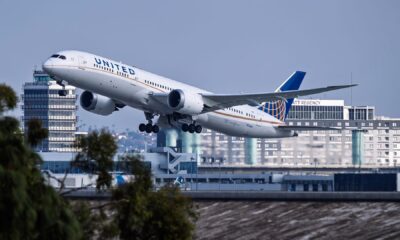World
American and United Airlines Battle with Boeing 777-300ER Fleet

American Airlines and United Airlines, two of the largest legacy carriers in the United States, are actively competing in the aviation market, particularly with their operations involving the Boeing 777-300ER. Both airlines operate this aircraft type, which is known for its size and capacity, but they differ significantly in terms of fleet size and operational focus. According to data from ch-aviation, American operates 20 Boeing 777-300ERs, with an average age of 11.7 years, while United has 22 jets, averaging 7.9 years old.
The Boeing 777-300ER’s design allows both airlines to maximize passenger comfort, particularly in business class, which is essential for long-haul international travel. The routes served by these aircraft reflect their strategic focus on high-value markets, particularly where business travel is prevalent.
American Airlines: Focus on Transatlantic Routes
American Airlines has scheduled a total of 710 flights for the Boeing 777-300ER this November, offering a substantial capacity of 215,840 seats. This translates to approximately 934.7 million available seat miles, as reported by Cirium. A notable highlight in American’s operations is its flagship route connecting New York JFK with London Heathrow, which is serviced twice daily. Additional key routes include daily flights from Dallas/Fort Worth (DFW) to London and connections from Charlotte (CLT) and Los Angeles (LAX).
The commitment to the Boeing 777-300ER is evident in its planned special centenary livery for 2026. When the first aircraft was delivered in 2013, Virasb Vahidi, Chief Commercial Officer of American Airlines, stated that the 777-300ER plays a critical role in the airline’s fleet renewal program, enhancing network flexibility and operational efficiency.
United Airlines: More Flights and Broader Reach
In contrast to American Airlines, United Airlines operates a larger and younger fleet of Boeing 777-300ERs, resulting in a more extensive operational footprint. This November, United has scheduled 781 flights, providing 273,350 seats and covering approximately 1.4 billion available seat miles. Unlike American, United’s primary routes for the 777-300ER are transpacific, with twice-daily flights from San Francisco (SFO) to Manila (MNL) and Hong Kong (HKG).
For transatlantic operations, United offers daily services from Washington (IAD) to Brussels (BRU) and Frankfurt (FRA). The airline also connects Newark (EWR) to Frankfurt and operates a unique mainland domestic route between Newark and San Francisco.
Onboard Experience: Layouts and Comfort
When it comes to onboard experience, United Airlines maintains a uniform layout across all 22 of its Boeing 777-300ER jets. Each aircraft features 350 seats divided among three classes. The Polaris business class includes 60 flatbed seats arranged in a staggered 1-2-1 setup, providing direct aisle access. This is followed by 24 premium economy seats and 266 economy seats, with 62 offering extra legroom.
In contrast, American Airlines offers two different configurations for its 777-300ERs. One layout includes four classes and accommodates 304 passengers, featuring eight Flagship First suites and 52 Flagship Business flatbeds. The second configuration seats 330 passengers across three classes, highlighting a significant investment in business class with 70 flatbeds, representing 21.2% of total capacity.
As both airlines continue to expand their operations and refine their offerings, the competition between American Airlines and United Airlines showcases the strategic importance of the Boeing 777-300ER in meeting the demands of international travelers. Each airline’s distinct approach to fleet management and route selection highlights the dynamic nature of the airline industry.
-

 World4 months ago
World4 months agoScientists Unearth Ancient Antarctic Ice to Unlock Climate Secrets
-

 Entertainment4 months ago
Entertainment4 months agoTrump and McCormick to Announce $70 Billion Energy Investments
-

 Lifestyle4 months ago
Lifestyle4 months agoTransLink Launches Food Truck Program to Boost Revenue in Vancouver
-

 Science4 months ago
Science4 months agoFour Astronauts Return to Earth After International Space Station Mission
-

 Technology2 months ago
Technology2 months agoApple Notes Enhances Functionality with Markdown Support in macOS 26
-

 Top Stories3 weeks ago
Top Stories3 weeks agoUrgent Update: Fatal Crash on Highway 99 Claims Life of Pitt Meadows Man
-

 Sports4 months ago
Sports4 months agoSearch Underway for Missing Hunter Amid Hokkaido Bear Emergency
-

 Politics3 months ago
Politics3 months agoUkrainian Tennis Star Elina Svitolina Faces Death Threats Online
-

 Politics4 months ago
Politics4 months agoCarney Engages First Nations Leaders at Development Law Summit
-

 Technology4 months ago
Technology4 months agoFrosthaven Launches Early Access on July 31, 2025
-

 Top Stories1 week ago
Top Stories1 week agoFamily Remembers Beverley Rowbotham 25 Years After Murder
-

 Entertainment4 months ago
Entertainment4 months agoCalgary Theatre Troupe Revives Magic at Winnipeg Fringe Festival





















